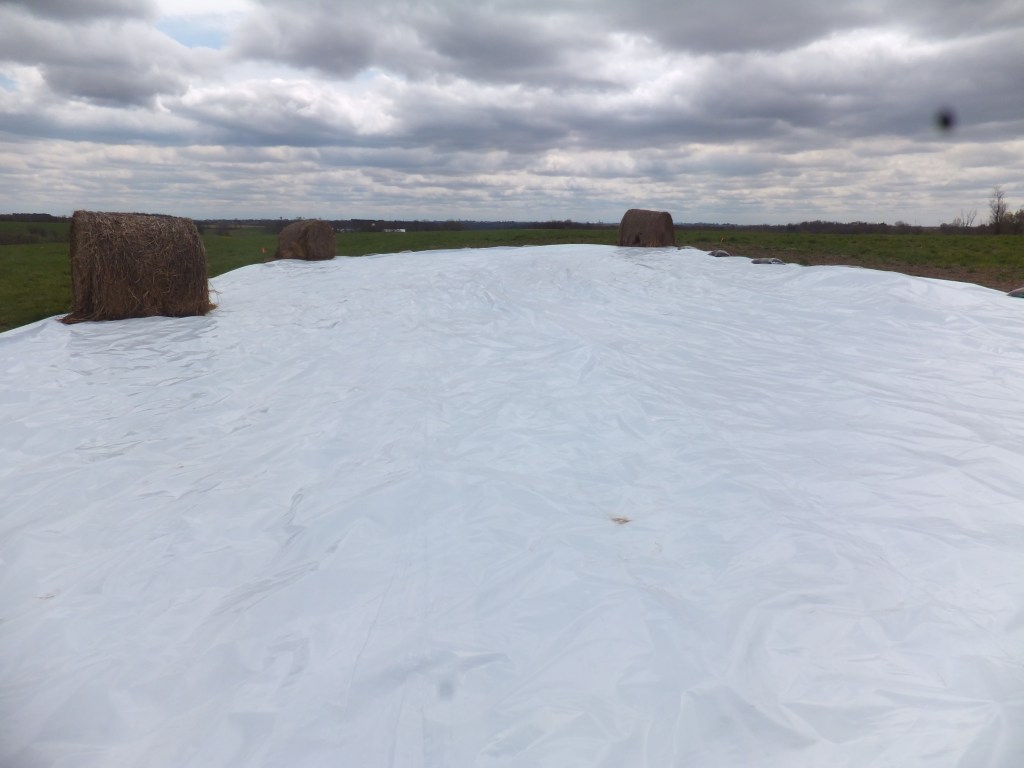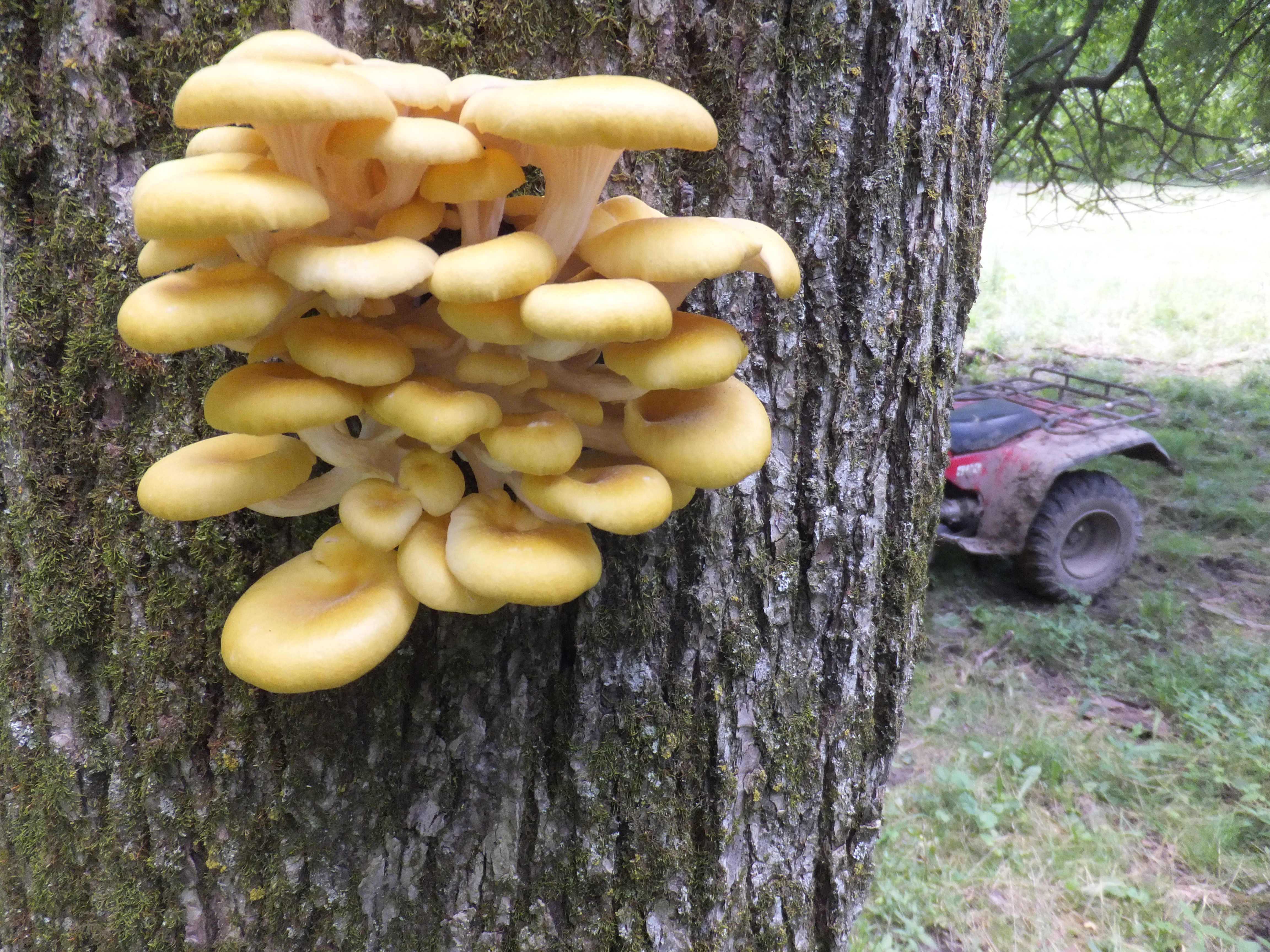
I’m not sure what kind of flower this is, but our out back pasture has a lot of it.

UPDATE: Taking orders for delivery every other Saturday to Madison. Next date: March 19th. Email Matthew with order and/or questions: oakgrovelane@yahoo.com. Thank you!
I felt like I was sprinkling Tinkerbell dust as I drove back and forth across an old hay field, Monday, March 14th.
I used our broadcast seeder, pictured, to frost seed Red Clover early in the morning before the sun muddied the soil.
We like our hay and pastures to have a mix of grass and legume. Grasses use nitrogen from the soil to grow. Legumes, with the help of bacteria near their roots, are able to pull nitrogen from the air and deposit into the soil. So legumes and grasses grow really well together.
Plus, cattle love a mixed sward so they can choose their bites based on whatever cattle base that decision on.
And we like making hay that is a mix of grass and legumes. Legumes are usually higher in protein. And grass dries faster, and cushions the legumes so their leaves don’t fall off as much when baling dry hay.
When we plant into a tilled field with our single disc grain drill, we plant alfalfa as the legume. Alfalfa is the most productive of the legumes in our area.
But when we frost seed, I prefer Red Clover over Alfalfa because Red Clover germinates easier than Alfalfa. As I’m writing this, my BS sniffer is going wild. I realize I’ve never experimented with this and it would be easy to do. I will experiment with this in the future!
Ok, the real reason is Red Clover is half the price of Alfalfa and its difficult to spend money when you are sprinkling seed on top of the ground and it feels wasteful.
I’m not sure why, as that’s how Nature plants most seeds, but we Farmers like control, and sprinkling on top of the ground feels more like a Faith based activity!
I’ll try to remember to update you on this project as the season progresses.

UPDATE: Taking orders for delivery every other Saturday to Madison. Next date: March 19th. Email Matthew with order and/or questions: oakgrovelane@yahoo.com. Thank you!
Lunched with friends today and one of them mentioned he would like to sell his Red Devon cows, bred for spring calving, and Bull. He’s going to focus on finishing more animals.
Contact me if you are interested and I can give you his contact info. Located in southern Wisconsin.

I swear I didn’t dig up the nest. As curious as I am, I’m also comfortable with mystery. The more I know, the more I know I don’t know.
But something did dig up the ground bee nest I’ve been watching. I’m guessing skunk. We’ve only had one bear sighting on our farm.
Below is a photo of some of the comb which was tore out of the nest. Have you heard of the theory that observing changes the observed?


Apologies for the quality of the photo, but I had to zoom to get this photo of my furry little friend. Can you see his face in the middle of the photo? He’s peaking out of the largest hole in the log.
I’m guessing he’s a Little Brown Bat, which is the most common species of bat in Wisconsin. Also, its a very small hole. I included my boot in the photo below for scale. The bat hole is in the largest log, center left of the photo, largest hole.
The only reason I was spending time observing this area is because I found a colony of bees entering and exiting the ground. The entrance to their home was not very visible, tucked under some of the woody debris. But about every 1 to 2 seconds a bee would be coming or going.
I’m guessing they may be a colony of Litigated Furrow Bees. They weren’t aggressive towards me as they continued their late summer work.


Welcome! New and Returning, Dane County Farmer’s Market Customers!
——–
We haven’t had any luck trapping a honeybee swarm and I think I know the obvious reason why: there haven’t been any swarms in the area. In fact, I haven’t seen any honeybees at the farm.
There used to be two beekeepers that kept hives within a mile of our farm, but I think they’ve quit and no one has taken their place. So no honeybees.
It doesn’t bother me too much, as I was worried about the effect that hives of European Honeybees can potentially have on the native pollinators. So I’ll probably take my swarm trap down at the end of this month and try again next year, possibly at a friend’s farm.
The good news is we have tons of native pollinators. I often see several young bumblebees on the same plant along with sweat bees and other wasps, beetles, flies, etc.
Below is a photo I took of a sweat bee, I think. And above is a nice wild patch of Monarda, or Bee Balm, thriving in our pasture next to a creek.


I purchased a silage tarp to prepare a seedbed for our sweet corn field. I’m hoping weeds will germinate under it, and then after I remove the tarp, I can plant into a cleaner soil.
We manage our sweet corn without heribicides or pesticides and weeds can be a problem.
Later, I plan to use the tarp to cover round bales of hay.
I was also inspired by a book, “Keeping Bees With a Smile,” which promotes natural beekeeping. The author claims an apiary can be started and maintained with wild swarms.
So I’ve installed a swarm trap and am looking forward to see if it attracts a swarm of honeybees.

If the swarm trap works, I know I’m going to feel bad for the native pollinators as some people fear that the European Honeybee with their huge numbers, may limit the nectar resources for the native pollinators.
So I drilled some holes in a log I’m leaving in a conspicuous place to see if I can get some native bees to nest.
UPDATE: Taking orders for delivery every other Saturday to Madison. Next date May 8th. Email Matthew with order and/or questions: oakgrovelane@yahoo.com. Thank you!

My friend Jeremy helped me identify delicious, Oyster mushrooms, (genus Pleurotus). While I don’t consider them to be as good as Morel mushrooms, they are still very good and have many advantages.
One is they are saprotrophic, meaning they grow on dead material, which makes them much easier to find, as once you find them, they tend to continue producing throughout the summer. I like foraging, but I like it even better when its like going to the supermarket!
Another advantage is they are highly productive. Check out all the beauties on this one tree.

In my research, I learned something else new. Wikipedia says Oyster mushrooms and other fungi as well are Nematophagous, which means they catch and eat nematodes. Nematodes are round worms. Are you getting hungry?
Gross factor aside, I’m finding fungi more fascinating the more I learn. Would you like to eat Oyster mushrooms?


The wet spring appears to be favorable for the butterflies, as I’ve been seeing a ton. Incidentally, which weighs more, a ton of bricks, or a ton of butterflies?

I’m seeing more Milkweed, which is the host plant for Monarch larvae, the Monarch caterpillar. Its orange, black, and white stripes signal toxicity to potential predators. The word for this is Aposematism.
Milkweed contains large amounts of Cardiac glycoside poisons, and the Monarch, from feeding on the Milkweed, does as well. Some predators have evolved workarounds for the poisons, though.

Check out the massive turds behind the caterpillar in the photo above. Chewed leaves and feces is your best signifier that a monarch caterpillar may be near.
I read in my local paper that its not just my experience, but scientists and citizen scientists confirm the greatest number of Monarchs in the last decade.
No doubt efforts by many of us to increase the amount of Milkweed and Monarch habitat have helped. Some have taken to mass rearing Monarchs indoors. While I appreciate their efforts, the holistic naturalist in me questions the overall effectiveness and it appears some agree, citing concerns over spreading of parasites and disease, and inadvertently selecting for less thrifty individuals.
What do you think?

“Farming with Family, Working in Nature”, is Curiousfarmer’s new motto. I borrowed this motto from a ranch, “Ranching with Family, Working with Nature.” I changed “Ranching” to “Farming” and “With” to “In”, because “Working with Nature” implies a level of cooperation by Nature, which doesn’t exist. I love Nature, but Nature doesn’t give a flip about Curiousfarmer.
The photo above shows an image I captured via trail cam after 98 chickens were killed in one night, photo below. You can see a few live near the dead. 30 were left alive, and they would have been quickly killed if I hadn’t moved them to a safer location.

One mink did all the killing. He only slit their throats, one after another. To the mink’s credit, he did return later to eat the dead birds, which is how I captured his image.

It seems like there is nothing tastier than a chicken on a farm. But predation is unpredictable. The only prediction I can make is you will have problems eventually. Last year the first and last group of chickens had zero predation. The middle two groups had quite a bit of trouble from raccoons reaching under and grabbing and eating on a chicken. We never had anything like this mink though.
If you would like to try our chicken, this Saturday will probably be your last chance before we sell out. I think we’re going to refocus on our beef, pork, and eggs, and leave the broiler chickens to someone else. We’ll also probably raise turkeys and butcher on the farm like the past two years, as turkeys are fun, and some of you really enjoy our turkeys.
